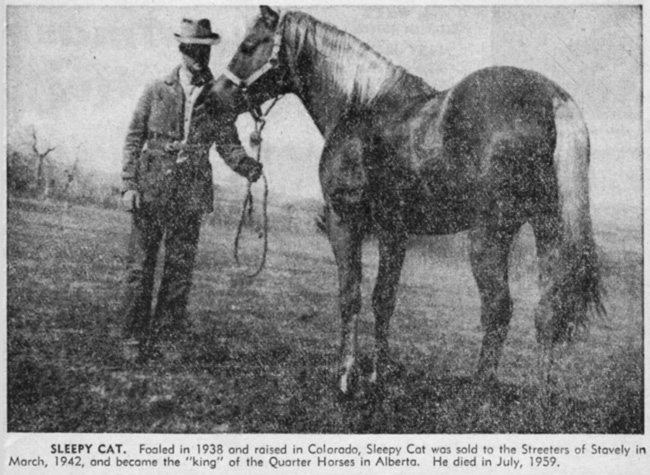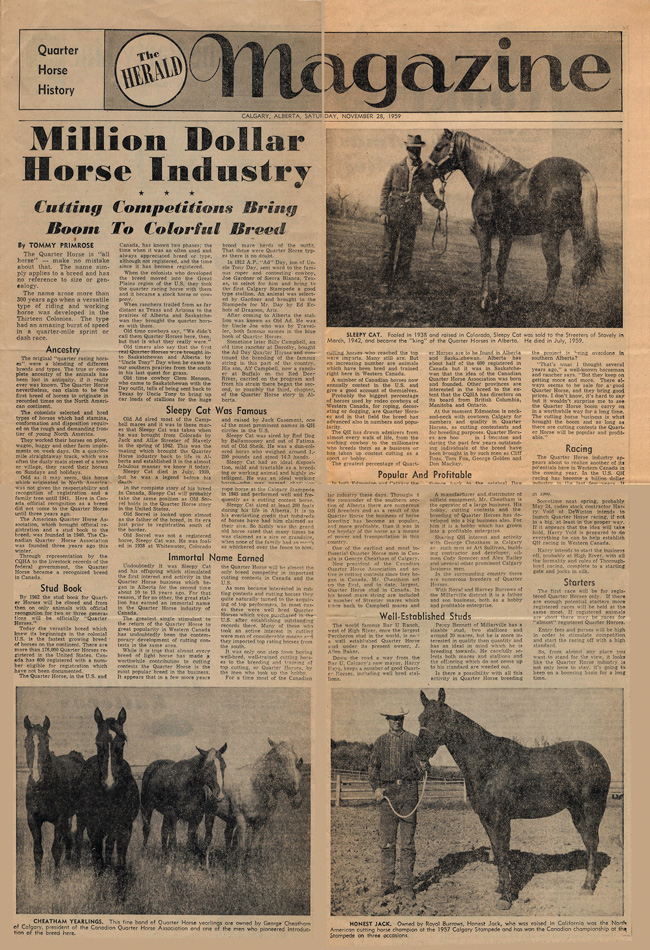

BY JENN WEBSTER
He was a dun-colored paragon of athleticism, beauty and charm, and was single-handedly credited for “…bringing back the Quarter Horse industry to life in Alberta,” as stated by a yellowed Calgary, November 28, 1959, newspaper archive of The Herald Magazine.
Foaled in 1938 in Colorado, Sleepy Cat was imported by brothers Jac and Allie Streeter of Stavely, Alberta in March of 1942. According to the first edition of The Butte Stands Guard, a historical book from the Stavely, Alberta area, this stallion was the first ever, registered Quarter Horse in Canada. There’s no doubt that following his importation into the country, Sleepy Cat clearly played a significant role in the Canadian Quarter Horse industry. In fact, The Herald Magazine went so far as to praise this influential Canadian sire for the probability that one day he would likely “…take the same position as Old Sorrel holds in the Quarter Horse story in the United States.”
Sleepy Cat was a versatile stallion who bore the American Quarter Horse Association registration number 620. He was a son of Red Dog (AQHA #55) by Ballamooney, and out of Fatima (AQHA #58), by Old Sheik. Sleepy Cat’s lineage traces back to the immortal beginnings of the AQHA and some of the most famous names in the blue book of Quarter Horses. Through circumstances, he is also linked to the original forefathers of the association – the gentlemen who first brought the AQHA registry to fruition.
Sleepy Cat was foaled in Whitewater, Colorado and was raised by Jack Casement, a prominent breeder of Quarter Horses and a most influential founder of the AQHA. Jack was involved with the AQHA from its earliest, most primitive beginnings. According to Volume 1 of the AQHA Stud Book and Registry, it was the dream of the late William Anson (Christoval, Texas) to record the origin and attributes of the Quarter Horse breed, and it is a well-known fact that Dan Casement of Manhattan, Kansas also “contributed to the general store of knowledge concerning these horses.” However, it remained an “untouched field” until the writings of Jack Casement (son to Dan), and Robert M. Denhardt of College Station, Texas, “drew the spotlight of public attention to the Quarter Horse.” Their articles to various magazines “found a surprising response among breeders and users of Quarter Horses throughout the west.”
Subsequent to this, the first serious discussion of a Quarter Horse organization was held in 1939. An informal meeting that included Denhardt among others, “formed the nucleus of an ever-increasing group of Quarter Horse enthusiasts and on behalf of this group a general invitation was extended to all interested parties for a meeting to be held in Fort Worth on March 15th, 1940, during the annual Fat Stock Show.”
On March 14, 1940, a preliminary meeting was held where both Dan and Jack attended and agreed to help with the preliminary work involved in the “foaling of such an organization.” After the official meeting was adjourned on the eve of the following day, it was reconvened as the first meeting of the American Quarter Horse Association and both Casements were elected to the newly appointed board of directors – Dan as an Honorary Vice President and Jack as a Director.
Back to Sleepy Cat. Jac and Allie Streeter were the sons of Harry and Mary Streeter. The Streeters had purchased the land that would become the “Streeter Outfit” in 1919, near Willow Creek, Alberta. It had previously belonged to James Ford. Harry was a long time aficionado of horses and can be credited with the production of one of the first indoor rodeos in Canada which he put on in 1929 at the Stavely, Alberta, skating rink. Additionally, he often held two-day rodeos on their ranch during the 1930s. Harry then turned to racehorses in the 1940s – Thoroughbreds, Arabians and Quarter Horses – and owned one of the largest racing stables in western Canada until he passed away in 1949. Harry’s sons had purchased the ranch from him in 1946.
Both Jac and Allie followed closely in their father’s footsteps and were excellent horsemen. When they found out the good horse, Sleepy Cat, was at Jack Casement’s place, they jumped in a truck and brought him home to Stavely. Both the paternal and maternal sides of Sleepy Cat’s pedigree could be traced to the Steel Dust legacy and the stallion would offer much to the Streeter breeding operation. Steel Dust was a Quarter Horse “type” foaled in 1843 who attracted much attention in the southwestern states as a sire of running and cow horses. Sleepy Cat inherited the fabled Steel Dust profile – the smooth and compact shape, short back and deep barrel – without falling heir to Steel Dust’s single flaw, a bulging jaw. Sleepy Cat’s head was more refined and charming, and he possessed a mind and temperament to match. He had “an ideal disposition – mild and tractable as a breeding or working animal and highly intelligent.”
Sleepy Cat earned equal credentials in the show pen as he did as a sire. At the 1945 Calgary Stampede, he was declared Champion Rope Horse – winning on the same day Jac and Alice Smith were married. Sleepy Cat won many laurels over the years, appearing in numerous cutting contests and roping events. He was sire to at least 200 foals during the course of his life in Alberta and was often used for the breeding of Campbell mares in the Ad Day Quarter Horse operation, owned at the time by Alf Campbell of Alberta. The Herald Magazine credits this mating as that “…which brought the Quarter Horse Industry back to life in Alberta and established it in the almost fabulous manner we know today.”


Sleepy Cat was held in such high esteem as a sire that often he was claimed as the sire, or grandsire of horses who never so much as nickered “over the fence to him.” Of some 200 foals, only 28 were ever registered with the AQHA and all are now deceased. However, of those 28 horses was Black Gnat, a black gelding owned by Coy and Casement of Buffalo, Wyoming. Black Gnat was the only documented performing offspring of Sleepy Cat and achieved his Open Performance Register of Merit in 1952. Many of the other listed registered horses were owned by Streeters or Campbells. Sleepy Cat was known to ranchers as a “solid gentleman,” and often stood to outside mares, so it’s likely the rest of his foals exceeded in ranch duties, cow horse and roping events and were scattered across western Canada.
In July of 1959, the much-loved stallion passed away quietly at age 22 in Streeter’s pasture. Gone but never to be forgotten, the horse’s epilogue would read, “undoubtedly it was Sleepy Cat and his offspring which stimulated the first [Canadian] interest and activity in the Quarter Horse business…”

